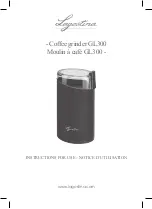
CERTIFICATE of AUTHENTICITY
I would like you to take a moment to read this
certificate regarding your machine. Each machine is
signed and numbered inside by me, handmade with
a great deal of pride to bring you not only a well
constructed quality machine that is aesthetically
pleasing but one that will bring you a lifetime of
pleasure in brewing the perfect espresso.
Each machine requires 36 pounds of brass and
copper, no assembly line and no computerized
machining is used.
I personally handle every piece and part of your
machine, each one is made individually and no two
are exactly the same. They are truly custom made
and hand crafted.
The care that I take in making your machine
I would like returned by you.
Take the time to learn how to brew perfect espresso,
always strive for the best.
Follow the guidelines prepared in this manual,
use good water, good beans, grind them on
demand and develop your hand.
Take care of your machine and follow all the
cleaning and maintenance instructions
I have total confidence in my art and in your
mastering the art and science of espresso
4) If the machine is left on and sometime later you want to brew more coffee
follow the procedure for preparing to brew espresso. Even though the group
is hot, the water in the heat exchange may not be perfect for brewing so by
running several blank shots you will get a perfect extraction.
The Push Pads
From left to right
The left pad has been programmed for a short single espresso 1.5 oz.
The middle pad for 2 singles or a double 3 oz+.
The right pad is a manual continuous flow until you press it again to stop.
Re-programming
Put ground coffee in the portafilter and engage it in the brew head.
Hold the far right pad for about 5 seconds until the light comes on.
Press the pad you want to change, extract the volume of coffee until it
reaches the new volume you want then press that same pad again to stop the
brew. Now the new volume will be just as you programmed it.
Steaming the Milk
1) Using the steam pitcher provided, fill the cold milk to 1/3 of pitcher
2)Place the steam wand in the pitcher about half way in the milk and open
the steam knob cautiously, do not blast it all the way open.
3)Immediately lower the pitcher so that the tip is slightly below the surface
of the milk, you will see the milk/air swirling through the holes this is
necessary to incorporate air for foaming. The sound you hear will let you
know if you are steaming correctly.
The sound is a soft deep airy one
NOT
high pitched screeching which means the wand is too deep and if you hear
bubbling or are making bubbles then the wand is too high. Do not worry
about heating the milk concentrate on foaming. It is difficult to advise you
about how far to open the steam knob while steaming, if it is not open
enough you will not get a swirling foam and if you open it too much you will
bubble and boil the milk too quickly.
4) As the foam rises lower the pitcher and watch for the swirling, so that the
tip is still just under the surface of the milk. After practicing
you will do all this automatically and the foam will rise to fill the pitcher.
5) When the pitcher is too hot to touch near the bottom then the milk is
ready. Do not burn or scald the milk because it will ruin the taste. The
temperature will be about 155 F.
6)
After steaming milk always wipe the steam wand and open and close
the knob to flush out milk left in the wand. You do not want Milk to dry
in the tip or wand nor do you want it to get backed up into the boiler.
Create PDF
files without this message by purchasing novaPDF printer (
http://www.novapdf.com
)
























